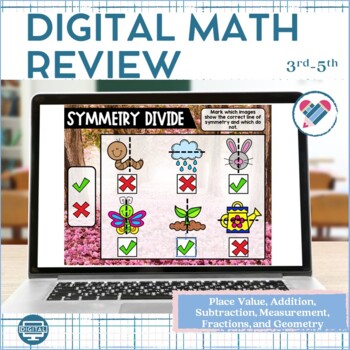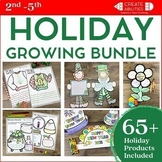Digital Spring Math Games | Math Review Upper Elementary
- PDF
- Google Apps™

What educators are saying
Also included in
- This set has 5,000+ pages that cover all of your holiday needs. This set is known as a GROWING BUNDLE. This means that as I finish more holiday products, I will add the to the set and the price will increase. If you have previously purchased this set, you can go to my purchases and re-download to gePrice $199.00Original Price $408.50Save $209.50
Description
You'll receive 310 pages of digital multiplication and division games and answer keys. These fun and engaging digital activities help your students practice multiplication and division math facts, as well as greater than, less than, and equal to.
There is no PDF version. Each page only comes in a digital format.
***Please note: If you are a supporter on Patreon, you already own a smaller version of this.***
Included In This Download:
- 155 pages of multiplication, division, and greater than/less than activities
- 155 pages of answer keys
Included Pages:
- Rounding Numbers
- Ordering Numbers
- What’s the Place?
- Equal Groups- Multiplication
- Equal Groups- Division
- Flower Arrays
- Dividing Flowers
- Multiplication Grid
- Dividing Up Flowers
- Divide It Up
- Symmetry Divide
- Sort It Out
- Comparing Shapes
- Hierarchy of Shapes
- Classifying Shapes
- Naming Shapes
- Detecting Angles
- Protractor Fun
- What’s My Angle?
- Plotting Points
- Ordered Pairs
- Map It Out
- Number Line Fun
- Discovering Number Lines
- Measuring Madness
- How Should I Measure?
- Find the Area
- Find The Perimeter
- Volume Fun
- Discovering Volume
- Flower Fractions
- Shading Flowers
- Matching Fractions
- True or False?
- Fraction Math
Please see the preview to get a better understanding of what's included.
Feedback is greatly appreciated!!
Print-and-Go Materials
All Create-abilities resources are designed with ease-of-use in mind. Don’t have a color printer? No problem. Pages that do not render well in black-and-white have black-and-white copies included. Be classroom-ready with a quick print.
★★★★You Might Also Like★★★★
●Digital Fall Math Games Addition and Subtraction
● Emotions Book for Social and Emotional Learning
● Classroom Procedures Book for Back to School
Enjoy!






